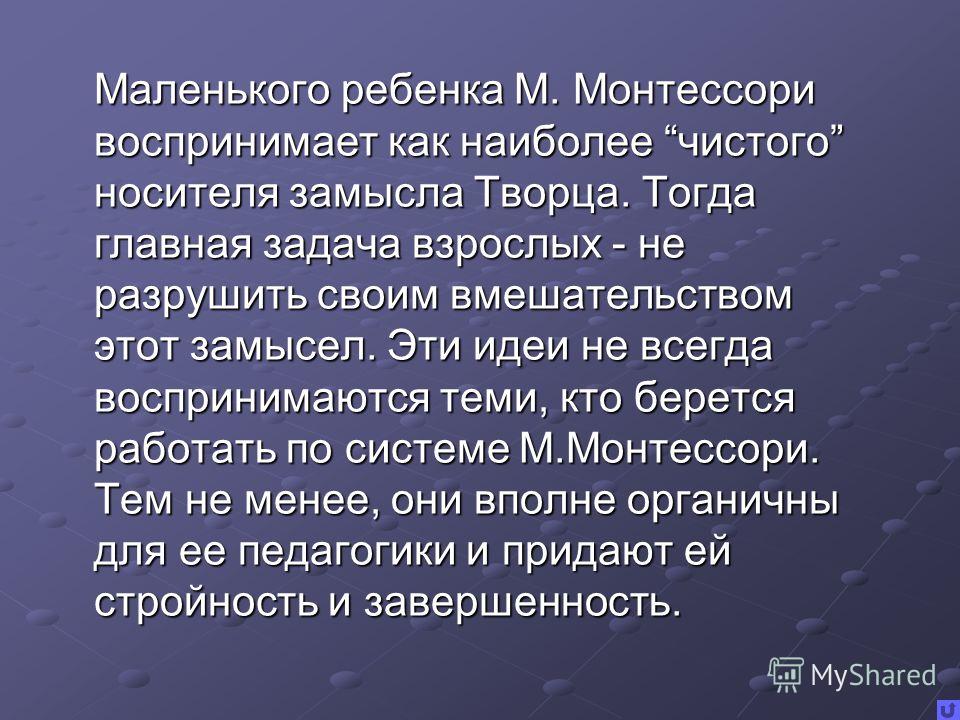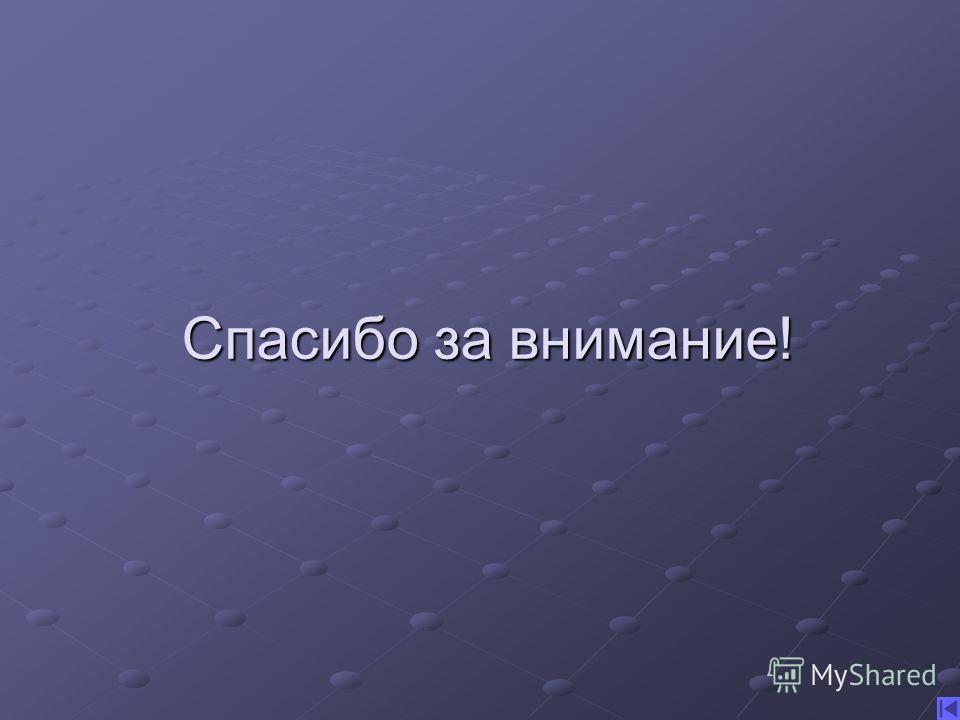What is the Montessori method?
The basic principle is to induce the child to self-learning, to self-development. The motto of Montessori educators: “Help me to do it myself.”
The meaning of the goals set in the upbringing of the child, according to the method of Maria Montessori: independence, self-confidence, respect for others, learning to order and hard work - FREEDOM. But, as Maria herself repeatedly paid attention to herself, “Freedom is not a wild“ I WANT AND WISH ”, it is a naturally developing inner ability to choose the best for oneself and others.
The concept is based on the criticism of the traditional education system, which reproaches that it is based on the authority of the teacher, on the use of methods oriented to his activities, which primarily cultivates the attitude of young people to adults and lowers concerns about the development of interpersonal cooperation. The separation of physical and intellectual activity was an unacceptable aspect in the formation of a young man who would integrate into a democratic and industrial society.
The classic concept implied the transfer of a set of information and exercises developed in the past. Dewey offers education that argues for the need for free expression of the student in an organically associated learning experience. The essence of education lies precisely in the fact that there is an intimate and necessary preparation between experience and education.
The task of an adult is to organize the conditions for the possibility of a child, independently, from early childhood, embark on their own unique path of development, to realize their NATURE.
Understanding this, Dr. Montessori developed a special environment - the Montessori class. Let's open the curtain and plunge into the unique atmosphere of the Montessori class.
... Light small chairs, an armchair, tables, for which one to three children can work, and which children themselves can bear. The material for classes “didactic material”, as Montessori calls it, is stored in long, low cabinets arranged along the walls of the room so that the children themselves can open them and put teaching materials in them. Dishes, which children use when eating, is such that children themselves can wash, serve and clean it on duty. Homework and "everyday exercises" are included in the lesson program. Maria Montessori has created an environment in which children should be the owners and employees themselves.
Dewey's educational process has two aspects: one is psychological and the other is sociological, the first of which is fundamental, to the extent that “the child becomes the sun, around which the educational means circulate.” He tries to reconcile psychology with social ones, emphasizing that development is impossible if the educational environment is not created to give an opportunity to manifest valuable potential and interests.
Interesting for his point of view is the concept of the discovery of the child's immaturity. If for classical pedagogy it was a drawback, that is, a negative aspect, there is a positive force for Dewey's immaturity, because thanks to her characteristics - dependence and plasticity - possible development. Childhood promises a lot, but there is no maturity. Childhood leads in many directions, while maturity already suggests closing in version. Having received autonomy much later than any other living being, a person can act differently in different situations.

However, this social and life-practical point is still in the background. “The purpose of education, in the words of Montessori, is to develop strength,” and this goal determines the nature of the “didactic material”, which the children are predominantly occupied and which undoubtedly constitutes the center of the entire Montessori system. The description of this material is not part of our task, especially since it is possible to familiarize yourself with it only by seeing it in practice or at least reading its detailed description in the books of Montessori itself. We will confine ourselves here only to clarifying the general spirit of the “didactic material.”
Dr. Montessori differentiates different feelings, and for each of them individually selects the appropriate material, exercises with which are able to develop it to the maximum extent. So for the development of tactile feelings are sets of smooth and emery boards, cards and various matters. Thermal feeling develop a set of metal cups filled with water of different temperatures. Baric (sense of gravity) - a set of identical in size, but different in weightwooden planks.
Thus, plasticity provides learning, which should not decrease after childhood. On the contrary, an adult should make an effort to preserve his curiosity, impartial reaction, franchise of the child’s concrete thinking. For his learning, this means developing the ability to recreate activity in new conditions or, on the other hand, to organize and reorganize experience, which, in addition to previous experience, increases the ability to direct the evolution of the next experience. An educated person is one who has the right to move on, to acquire other experiences by virtue of experience.
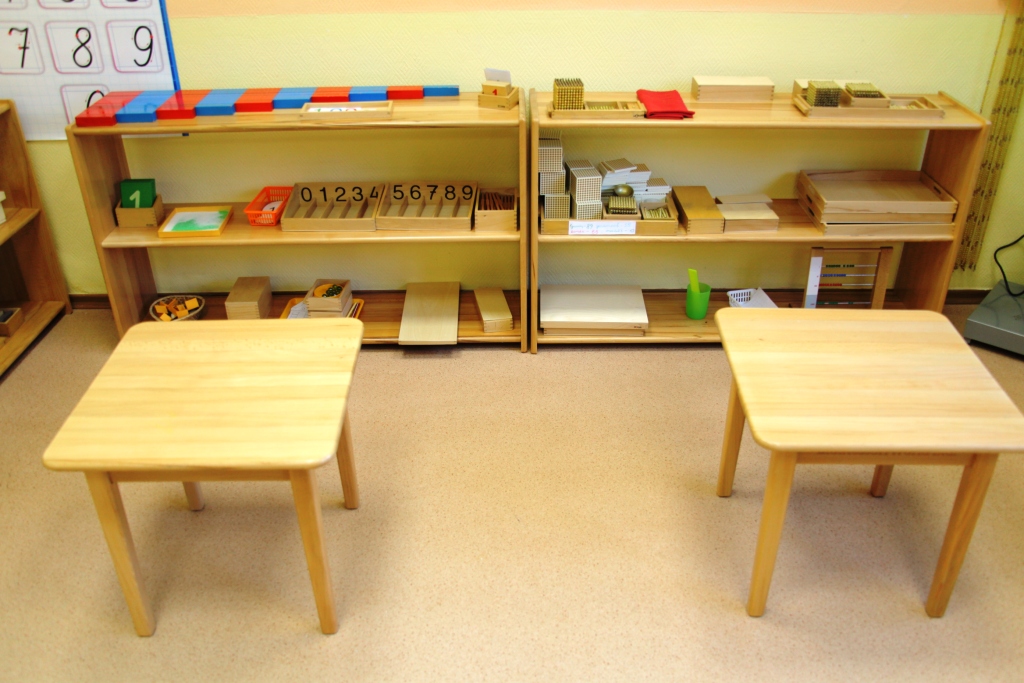
For the development of stereognostic feelings (feeling), Montessori uses a set of geometric shapes. The eye and the sense of form and color are brought up accordingly. Hearing is developed with the help of a set consisting of two rows of 13 bells each and 4 hammers (recognition of tones) .... Based on the idea that the task of education is the development of all human powers, Montessori does not disregard the sense of taste and smell: for the development of them are sets of different powders and liquids. For each feeling, a special material is selected, and this isolated exercise of a separate feeling is aggravated by a special “isolation method”: for example, auditory, tactile and thermal exercises occur with blindfold, i.e., when you turn off the sense of sight, etc.
Raised should be a "benefactor" who uses the experience of incorporating new experience. Real experience is important to the extent that it prepares a person for future experience. Ideas are true to the extent that they are used and help to effectively transform reality. In other words, ideas are not true, but they become real in concrete actions when they obey the practice of evidence.
Of particular importance for the analysis is its didactic concept. According to her, this means creating certain situations in which young people acquire the same meaning as adults in the environment in which they live, knowledge that gains authenticity through their direct source, experience. In the process of experience, thinking "experience includes knowledge." It is on this basis that the unity between practice and theory is very desirable for students participating in the action. The experience is all the more valuable because the class of students is trained.
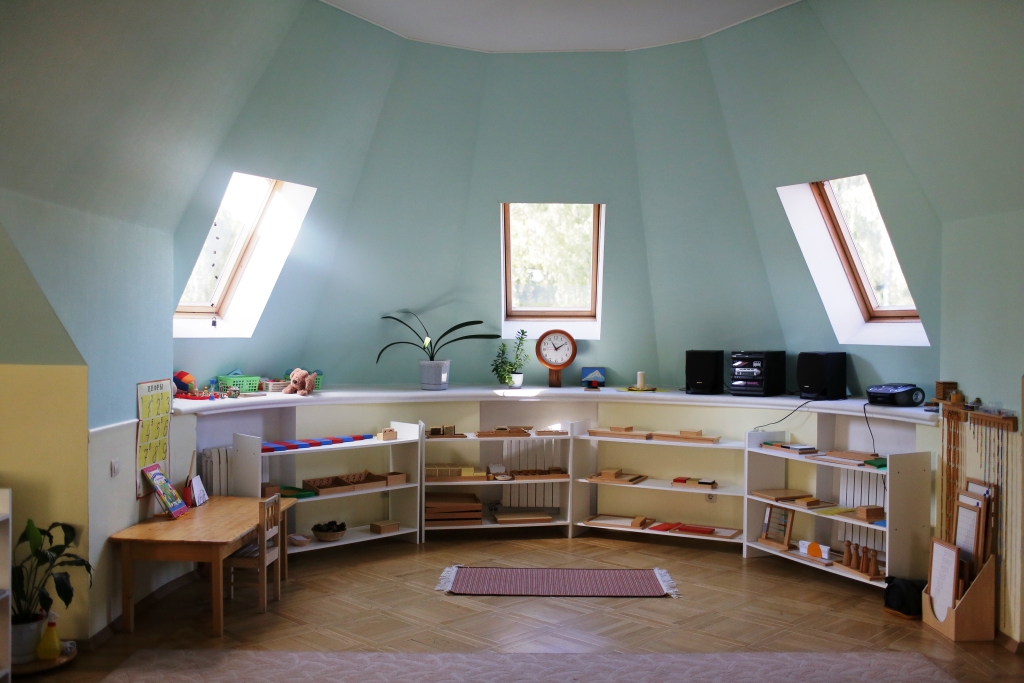
Similarly, the training of movements takes place, which is largely reduced to the exercise of muscles involved in different motor processes: in addition to the system of specially developed gymnastics, exercises with buttoning and unbuttoning buttons, lacing, and special breathing gymnastics serve for this purpose. Upbringing mental activityFrom the point of view of the Montessori method, there is nothing more than a combination of perception with motor processes, reduced to a combined exercise of the sense organs and motor processes: these include “nomenclature lessons” related to the exercise with geometric inlays (learning form and color) and complicated observing the environment under the guidance of a teacher, playing with cutting out geometric figures, drawing according to the developed system (black hatching, then color, etc.), modeling, games with the names of colors and their shades, etc.
Thus, they studied botany, arithmetic, geometry, chemistry; therefore, familiar knowledge becomes tools for solving new problems arising during new experiences. Spencer that "the school is preparing for life," instead offering the idea that "school is life itself."
Final conclusions about didactic methods, methods that should ensure the similarity of teaching situations with life situations. Although he maintains the formal nature of the distinction between “what we experience” and “how we experience”, J. Dewey agrees with the usefulness of studying the causes of success or failure of a school, that is, the fact that teaching methods is a field of personal interests. From this position, he emphasizes the creative role of the teacher in developing a methodological route, which contradicts some prejudices that see the routine didactic act.
.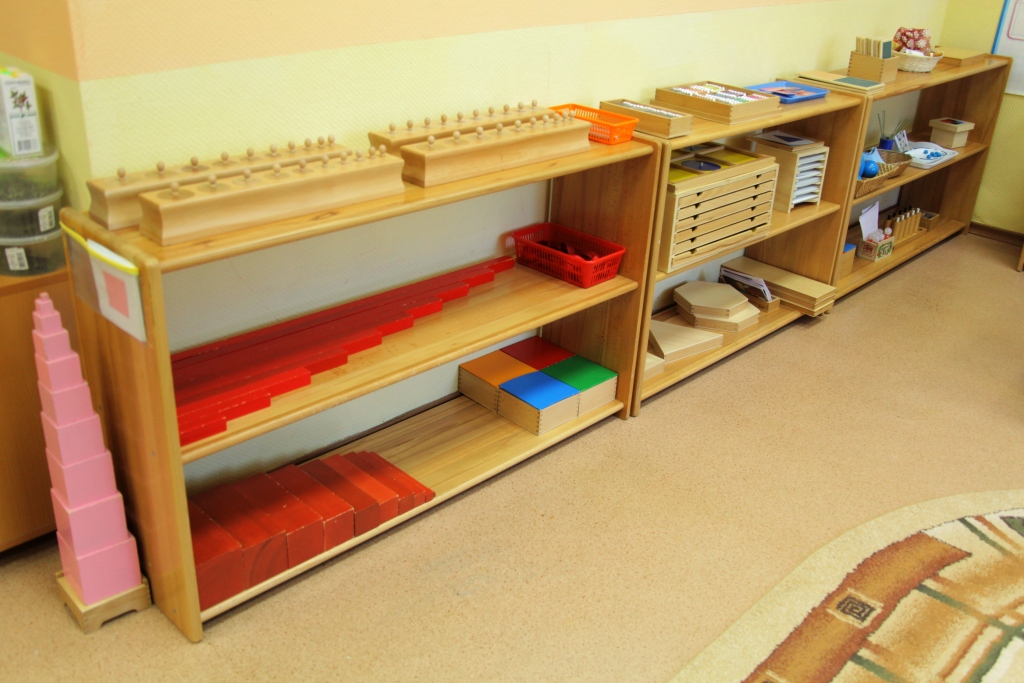
All this ends with exercises aimed at introducing arithmetic (exercises with numbers, “lessons with zero”, exercises for memorizing numbers), and finally culminates in the method of teaching reading and writing that has acquired particular fame.
The main task of the teacher in relation to the child directly in the process of training is not to prevent him from mastering the world, do not transfer your knowledge, but help to collect, analyze and systematize your own.
Nothing led to a deterioration in the reputation of pedagogical theory than the conviction that she identified herself with the prescriptions and models of teachers who will be taught in teaching. Concerned about the definition of the method best suited to his intentions, theorizes the method of the problem. We present the steps that the author considers necessary when using the method.
Creating an empirical situation similar to the child’s previous experience; the occurrence of obstacles, the formation of a problem that stimulates thinking; activation and use of data from previous experience, information obtained in various ways; formulating hypotheses to solve the problem, analyzing their likely consequences; choosing the most plausible hypothesis and testing it in practice. If the hypothesis is confirmed, it means that it will become an effective tool for future action. This proven hypothesis is just an acquaintance. . It can be seen that in its main lines the proposed method is subordinated to a learning strategy for discovery, far surpassing learning as an accumulation.
Montessori in the world
1907 is deservedly considered the beginning of the history of the development of the Montessori method in the world. It was this year, January 6th,

in the Italian city of San Lorenzo, the first Montessori school “House of the Child” (Casa dei Bambini) was opened. Here, Maria Montessori had the opportunity to widely put into practice the results of her first observations and experiments, to check the correctness of the conclusions made.
Already by 1909 it became clear that the experiment carried out by Montessori was successful. Since that time, her bright star has established itself in the pedagogical sky. At this time, the fame of Dr. Montessori goes beyond the borders of Italy. Teachers are starting to come from Spain, Holland, England and Sweden to get acquainted with its methodology.
One of the main advantages of the method is that it causes intrinsic motivation caused by the student's spontaneous interest in overcoming the obstacle. Interest will be reinforced by efforts and will solve the problem of school discipline, as students do exactly what they want to do. Dewey derived a learning system based on the freedom of students to choose one or another educational discipline, a system with wide acceptance and application today.
In conclusion, the pedagogical theory of J. Dewey is imposed until today. Emphasis on the development of personality, capable of solving the problems of living together through association and cooperation. Stimulation of active education care, which is largely able to take into account the individual characteristics of students.
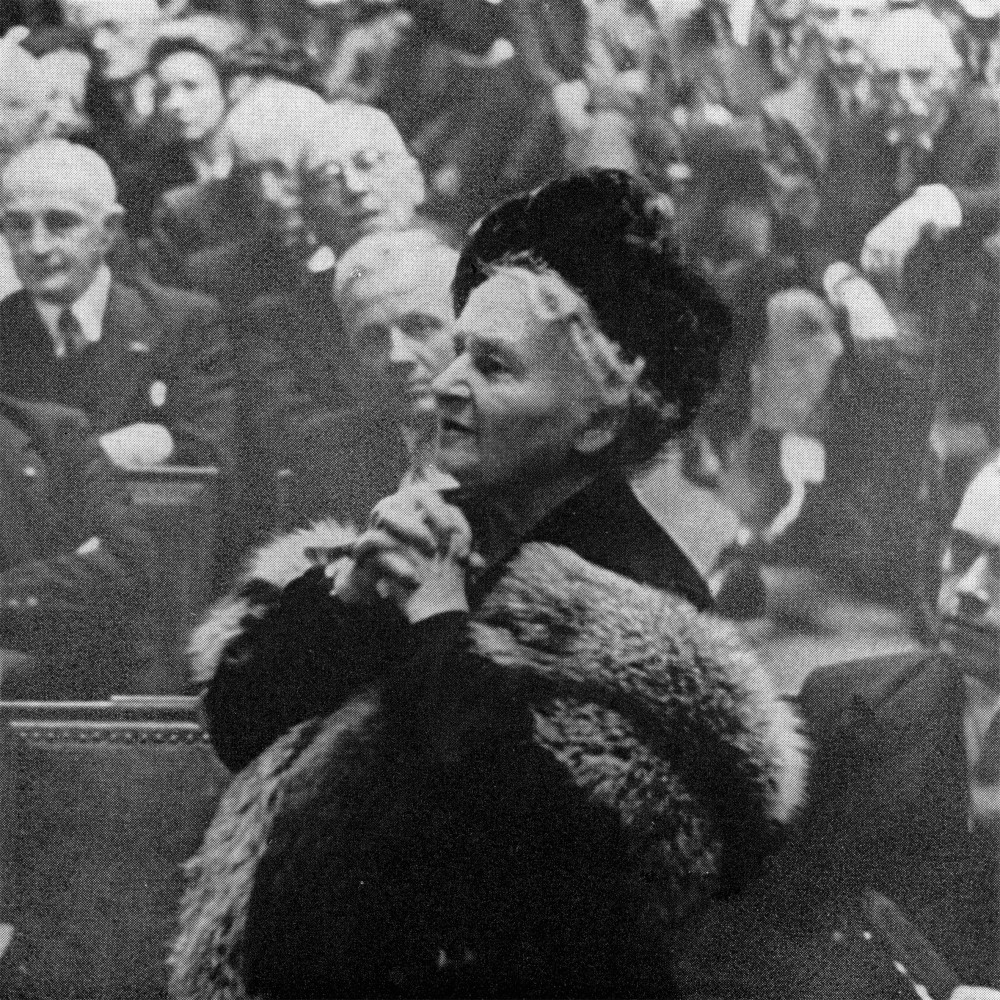
For several years, Maria Montessori has traveled extensively in Europe, performing in the USA, South America, and Asia. Everywhere, where she was, there were child care facilities, working according to her method.
AT short term Montessori method has spread around the world.
In 1929, Maria Montessori together with her son Mario founded the Montessori International Association AMI (Association Montessori International) in Amsterdam (Netherlands).
Since 1960, the American Montessori Society - AMS (American Montessori Society) begins to work in the city of Greenwich (USA).
There are several thousand Montessori schools in the world, only in the Netherlands there are more than 200s.
The orientation of the American school to practice. Stimulate the creative activity of teachers, the trend towards innovation in education. Maria Montessori, a worthy follower of J. Rousseau, developed a concept focused on the unlimited endurance in strength and transformative ability of education, to the extent that she is responsible for solving all social problems. The areas where the strongest echoes of his theory were felt were: pre-school education, work with mentally disabled children and teachers.
As a psychiatrist and pediatrician, he completed medical and pedagogical methods, finding an improvement in the evolution of "abnormal" children, which allowed him to expand the use of these methods in raising children with normal development. The theoretical efforts of the Italian teacher began with a criticism of experimental pedagogy, which reproaches him for only reducing anthropometric measurements and compiling statistics that only fix external sign the reality of child mental life.
In the USA, in Europe, Asia, there are special factories producing its didactic materials.

One of the Montessori schools in India, City-Montessori, in 2013 was officially recognized as the largest in the world and entered into the Guinness Book of Records. Today, about 47 thousand students study at this school.
Montessoria knows that a child does not mean to apply tests, but to see that he knows his development laws. Genuine knowledge of the child can only be achieved at large. That is why freedom becomes the condition and method of learning. At this level of analysis, the author finds that the school of time does not provide this condition, which requires significant changes, extensions to find it at the level of education and training methods.
The novelty of the Montessori method is to provide an organized environment in which the child is free to express himself, through the freedom of the child, who understands its manifestation in the conditions required by nature. The child does not imitate, but absorbs everything that is needed around him, and then turns into his own substance. In man there is a natural impulse to growth, to his own image. It has several stages, manifested by a providential plan. Each stage, called a “reasonable period” by a teacher, implies a certain essential need; his satisfaction prepares the way for the appearance of another.
Montessori in Russia
The first information about the success of the Montessori method reached Russia back in 1910, but the Russian pedagogical community was quite familiar with the Maria Montessori system in 1913, when the Russian translation of its main work was published under the title “Children's Home. The method of scientific pedagogy.
If the need is not achieved, development will not be achieved, and the spirit will be atrophied. For example, reading is assimilated if a child has cut out or squeezed letters, if he had access to them, if they became so familiar that he came spontaneously through a real explosion to a new conquest — reading. From this it follows that for the education of the child only one condition must be fulfilled: to give him what he needs. Otherwise, if he passed this age, his interest no longer manifests itself.
In the circumstances, the child is not a teacher, he is not modeled, he built independently. The role of educators should not be deterrent, with the sole purpose of helping children and helping them meet their own needs. The emphasis on the biological dimension of the Montessori concept becomes even more apparent when, insisting on the role of instincts in the development of a child, it reduces the role of the teacher, which remains one of the conditions necessary to meet the needs. The activities of teachers include.
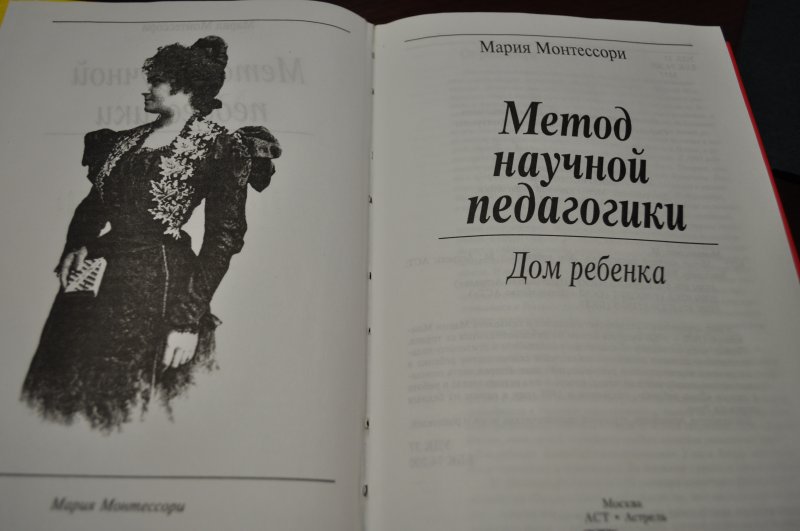
The book immediately attracted attention with its originality and applied focus. Around the ideas set forth in it, heated debate ensued. In the autumn of the same year, a presentation of the didactic material Montessori took place at St. Petersburg University, and later at the Pedagogical Museum, which received enthusiastic responses from most visitors.
The first practical step in the implementation of the ideas of M. Montessori in Russia was made by Yulia Ivanovna Fausek (1863-1943). Having energetically set to work, already in October 1913, at one gymnasium, she created a small kindergartenworking on the Montessori system. For twenty years, she tirelessly promoted the method, published more than 40 of her books and articles, published several papers by M. Montessori in Russian. In 1914, after spending a month in Italy, Yu.I. Faousek was further strengthened by faith in the rightness of the case for which she had undertaken.
Support for children in the identification of the necessary materials and their use. Intervention requested by children or when it is in childhood is disturbed by others. This will ensure respect for the freedom of the child in the Monteser education system, as in no other educational system.
Among the aspects in which the intervention of teachers becomes visible, the preparation and organization of the “material for development” corresponding to each period of the child’s development is a priority. It was designed for every meaning. He pointed out the size, shape, color, tenderness for bodies facing the sight and touch. It consisted of working materials to encourage writing and reading learning activities. With the help of these materials, problems were created that would correspond to the tendencies to the activity of the child or would stimulate this activity.
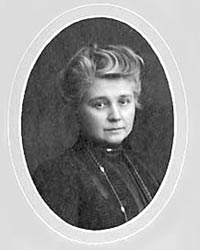
Based on the garden of Yu.I. Fousek was created in 1916 by the “Free Education Society (Montessori Method)”, during which courses were introduced to familiarize with its system. As a result, several Montessori kindergartens opened in Russia: two - in the village of Lesnoy (near Petrograd), their leaders went to New York and bought didactic material; one garden - in the province, in the city of Kirillov, Novgorod province. Special gardens were opened under the Trusteeship of the Poor and the People’s House of Countess Panina.
Despite the objective difficulties caused by the war and revolution, Yu. I. Fausek remained true to his work and in the spring of 1917 created the Montessori kindergarten in Petrograd, which withstood the upheavals of the civil war. In 1922-1923 He was visited by four hundred and seventy-five delegations, mostly provincial educators and even peasants, who were keenly interested in the system. Despite the controversy surrounding this system and its criticism, the children enthusiastically engaged with Montessori materials and amazed with their development successes. This was the main argument propaganda method.
Gradually, more and more Montessori gardens began to appear in Russia. In Moscow - the “Cologne House” on the Maiden's Field (headed by A.A. Perrot), a garden under the direction of A.P. Vygotsky, a garden for deaf-and-dumb children Sokolova; a house in Vyatka, as well as four kindergartens in Tiflis in which a student from Montessori taught. In October 1923, the Montessori Scientific Circle was opened at the Institute of Preschool Education, in which for the first time a scientific study of the possibilities and ways of using the method in domestic conditions was undertaken.
However, in 1926, this system, which places the cultivation of individuality at the head, was banned by the Bolsheviks.
Since the late 1980s - early 1990s. Montessori - the movement is going through the second stage - the period of rebirth. The second period can be divided into two stages. The first stage - until the late 1990s. - perception of the experience of foreign colleagues and appeal to the experience of Russia at the beginning of the 20th century. This is the stage of "movement in breadth." Since the late 1990s. the second stage begins - “going deep”, i.e. in-depth understanding of the Montessori heritage, the first scientific research and serious study guides. At this stage, there is a need for comparative experimental studies of the effectiveness of the Montessori system on Russian soil.
In the summer of 1991, teacher and journalist "Uchitelskoy newspaper"

E.A. Hiltunen and Dutch teacher E. Van Santen signed a cooperation agreement. It was planned to open kindergartens, seminars for teachers and the organization of the production of Montessori materials in Russia.
The authorities also did not remain aloof from the Montessori movement that is gaining strength - the movement. In the first half of the 1990s. The Ministry of Education of the Russian Federation and the Ministry of Education and Sciences of the Netherlands signed a Memorandum of Cooperation in the humanitarian fields, on the basis of which the Metropolis project was developed. Within the framework of the project, Dutch specialists cooperated with teachers from Volgograd, Krasnoyarsk, Moscow and Cherepovets.
The first messengers of Russia to foreign Montessori courses were E. Hiltunen and M. Sorokova.
In 1992, on the initiative of D.G. Sorokov, M.G. Sorokova, K.E. Summative and S.I. The Moscow Montessori Center, which carried out work in different directions, was created as a doubtful one. The course was taught by both domestic and foreign specialists. On the Russian side, lectures were given and candidates and doctors of sciences MV held seminars. Boguslavsky, G.B. Kornetov, D.G. Sorokov, M.G. Sorokova, R.V. Tonkova-Yampolskaya.
Currently in Russia, more than a thousand groups in kindergartens working on the Maria Montessori system, there are many seminars and conferences, both on a national and international scale. There is a serious work on a deeper study of the method of Maria Montessori, and the use of theoretical knowledge gained in practice.
Biography of Maria Montessori
... Maria Montessori ...
Why is the great woman's biography so interesting to us?
Knowing any method is impossible without knowing the history of its creation, the history of creation is the history of the creator. In our case, this is Maria Montessori.
We hope this small excursion into the biography of Dr. Montessori will help you to better understand the motives and circumstances of the emergence of this unique child development methods.

Maria was born in the provincial Italian town of Chiaravalle on August 31, 1870. The Montessori family was quite wealthy, and since Mary was the only child in the family, her parents did everything they could to give her a good education. The young girl's dream was the profession of a pediatrician, and at the end of the gymnasium, Maria enters the medical faculty of the University of Rome, two years later she receives the right to study not only natural science, physics and mathematics, but also medicine.
It is important to understand that Europe at that time was far from being so democratic and emancipated as it is now. Somehow whatever heights, especially in science, a woman was simply impossible to achieve. But even such seemingly insurmountable obstacles could not stop Maria on her way to the DREAM.
And at the age of 26, Maria Montessori became the first woman doctor in Italy. Even then, known for her advanced views, Dr. Montessori began working as an assistant professor at a university psychiatric clinic.

Working in this clinic, every day, watching children with mental disabilities, studying the works on child psychology and pedagogy, Itard, Jean Marie-Gaspard (1775-1888), and Seguin, Edouard - (1812 1880), Maria came to a surprising conclusion: the problems of mentally retarded children are not MEDICAL, but PEDAGOGICAL PROBLEMS. And they need to be solved not in the hospital, but in the school. From that moment on, the fate of Maria Montessori took a sharp turn. Dr. Montessori becomes the director of the Ortofrenic School, in which children with delayed development. A year later, many of her students learned to read, write, and passed exams along with healthy peers.
In addition to psychology and pedagogy, Maria Montessori was attracted by anthropology, mainly the issues of human evolutionary development - natural factors affecting mental development child
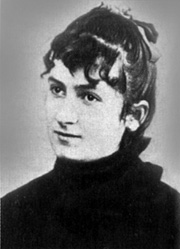
Maria Montessori 1908
In 1904, Maria headed the department of anthropology at the University of Rome. It was during this period that she developed the now so popular Montessori materials, formulated the foundations of her own pedagogy, and was working on a new method of teaching children to read and write.
At the beginning of the 20th century there was a time of great social experiments in Europe. In Rome, it was decided to modernize the working quarter of San Lorenzo. Project manager Eduardo de Salamo suggested that Montessori take over the leadership of the educational part of the project. She agreed, because she had long felt the need to try out her method of education in healthy children.
On January 7, 1907, the first “Baby House” opened in San Lorenzo.
60 children, whose families settled in new houses, gathered in a large room, which became the prototype of the modern Montessori class. The results obtained by Maria Montessori surpassed all her wildest expectations. She threw everything: lectures at the University, professorial practice, good earnings, for the sake of a new, unknown, but attracting business - the creation of a new pedagogical system of free self-development of children.
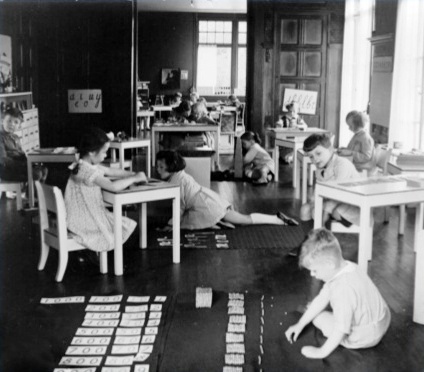
It's amazing how fast the news about the Montessori method spread throughout the world. Teachers from England, France, Russia, America, went to Mary, to get invaluable experience new technique. In 1910 the book "Montessori Method" was published, and it was immediately translated into 20 languages of the world. Dr. Montessori was not only the pride of Italy, but hardly the most famous teacher of the planet. Maria Montessori lived her life in an endless struggle for the rights of the child. She called her method - the method of scientific pedagogy and believed that any practical actions, theories, models can be built only on deep knowledge of a developing person.
In 1950, Maria Montessori was awarded the honorary degree of a doctor, a professor at the University of Amsterdam, and she was nominated for an international Nobel Prize.
Maria Montessori died in 1952 in Noordwijk, Holland.
Evidence of the worldwide recognition of Maria Montessori was the decision of UNESCO in 1988 to include it in the four teachers who determined the method of pedagogical thinking in the 20th century. These are John Dewey, Georg Kerschensteiner, Anton Makareno and Maria Montessori.
TERMINOLOGY OF MONTESSORI-PEDAGOGY
Sensitive (as is customary in psychology and pedagogy) or sensitive (term from medical practice) periods - periods of special susceptibility to various activities and ways of emotional response. During these periods, certain qualities and psychological features person Sensitive periods are inherent in absolutely all children and pass irrevocably. In Montessori pedagogy, the sensitivity of children under 6 years of age is known. Sensitivity and periods of child development are sometimes confused.
Montessori materials - child development tools (didactic aids), selected by Maria Montessori as a result of observations of children. All materials are ordered by degree of difficulty and are freely available to the child, as well as having a number of special characteristics, such as isolation of difficulties, error control, etc. All benefits are visually attractive, made, as a rule, from natural materials of high quality. The main task is to stimulate the individual development of the child. In the course of work (play) with the material, certain psychological qualities form in the child, internal motivation to learn develops.
Montessori Pedagogy - scientific pedagogical system of education and education of children under the age of 12 years, developed by a doctor, psychologist, teacher Maria Montessori (1870-1952). Currently, there is an international system for training teachers working with children of different age categories (from 0 to 3, from 3 to 6, and from 6 to 12 years) within the framework of Montessori scientific pedagogy.
AMI (Association Montessori International) - International Montessori Association, founded in 1929 by M. Montessori herself and her son Mario. For a long time, the granddaughter of M. Montessori Renild was her general secretary. Headquartered in Amsterdam (Netherlands). Oversees a network of Montessori teacher training courses. Prepares and approves Montessori trainers. Conducts the pedagogical councils of the Association, where he discusses and approves changes in the methodology, based on observations of children brought up in the Montessori system.
AMS (American Montessori Society) - The American Montessori Society is a huge organization that promotes Montessori education in the world. AMS began its activity in 1960 in Greenwich, now spreading its influence over six continents.
AMS has its own standards and criteria for accreditation of Montessori education. The AMS approach in Montessori is characterized by the adaptation of the Montessori system to the realities of today, to the different mindsets of children, and takes into account the development of modern technologies.
Normalization - the process of maximally optimizing the development of a child, during which deviations in his development are deviant in nature. Normalization occurs due to free work in a specially prepared environment. Normalization of a particular child can be determined by the absence of deviations in behavior and the acquisition of a number of qualities.
Absorbent Mind (Absorption) - the natural property of a child from birth to six years to spontaneously perceive, fix, memorize impressions (signals, information) from the outside with the help of all the senses and transform them into your personal experience to adapt to the environment and the formation of his personality.
Concentration - ability for continuous, intensive work with one didactic material.
Prepared environment - such an environment of the child in all its aspects, with all its subjects and relations, which gives him the opportunity for the most complete optimal physical, spiritual and intellectual development. This concept includes a number of psychological and pedagogical (consideration of business, humanistic tendencies, etc.) and organizational aspects (the presence of certain didactic material, a trained teacher, etc.). A full-fledged prepared environment can be created only in the conditions of a training institution.
"Explosion" in training - spontaneous process of transition of quantity indirectly accumulated knowledge into a new quality. For example, the "explosion of the letter." As a result of the development of the arm and muscular memory (through a series of exercises), the child acquires the ability to write letters correctly.
Sensory materials - designed to build the child's intelligence. The initial task is to refine the senses, to build pairs (noise boxes, etc.) and successive rows in a group of homogeneous objects (pink tower, brown ladder)). The ability to organize and classify is the basis of intellectual activity.
A circle - a group lesson (a lesson on the line), which necessarily contains a specific problem, task, teaching moment. Circles have a direct and indirect goal, material, presentation, the ability to control and correct errors, directed to certain sensitive periods. The circle is the "place of organization of thinking and consciousness."
CREATING A MONTESSORI-MEDIUM HOME FOR A CHILD OF 3-6 YEARS
It is believed that at the age of 3-6 years old the child “creates himself” and should not be disturbed. The child is aware of himself in society and learns many adult things. Wednesday Montessori from 3 years is to create 5 zones:
Zone 1: Practical life exercises
Zone 2: Sensory development
Zone 3: Mathematical Zone
Zone 4: Language Zone
Zone 5: Space Zone
PRACTICAL LIFE AREA. These are materials that promote the development of self-care skills: brushing your teeth, cleaning, washing dishes, doing laundry, cleaning clothes and shoes, tying shoelaces, and so on. If parents have the opportunity to purchase special Montessori material for classes - this is good. Specialized sets, as a rule, include the following things: frames with fasteners of all kinds, sets of dishes, sets of brushes and basins, clothespins, containers for pouring and pouring, sponges, rags, dustpan and broom. A set of objects, as we see, is uncomplicated. It is not difficult to acquire all of the above in an ordinary hardware store, except, perhaps, a framework. The fastener frames (velcro, lacing, buttons) are easiest to make yourself.
The TOUCH DEVELOPMENT AREA is an area of development of feelings: touch, smell, sight, hearing. Materials that help a child understand and remember physical laws and concepts: color, shape, temperature, sounds, smells. These include tissue samples, stands with geometric signs, multi-sized objects (a tower), colorful shapes and sets of tablets for sorting by color and shape.
The MATHEMATICAL ZONE from 3 years old and older is aimed at the formation of not only knowledge about numbers in a child, but also at the simplest actions with them: addition, subtraction, division into fractions. Below is a selection of special Montessori material, which includes sets with textural numbers, scores, sets of figures giving an idea of fractions, wooden boards with examples of calculations, a game - a lotto with numbers, cards with symbols of numbers 1,10,100,1000.
RUSSIAN LANGUAGE ZONE, mainly, includes materials demonstrating the form and types of writing letters. This is a box office of letters and syllables, sets of capital letters and block letters, textured letters. Of course, familiarity with the native language is not limited to the concept of letters. Nothing develops speech like reading, so books and games for vocabulary development should also settle in this area.
The SPACE ZONE is responsible for the formation of the knowledge of a small person about this world and for the development of his ideas about himself. Special manuals, geographical maps, didactic material explaining the origin of things and phenomena of nature, books about nature are capable of helping him in this.
(by mat. Maria Tretyakovskaya)
But creating it all at home costs a lot of money. And the full use of the environment requires special knowledge. Therefore, many parents prefer to give the kids to montessori classes or to children's montessori gardens.
MONTESSORI METHOD
What is the Montessori method?
The basic principle is to induce the child to self-learning, to self-development. The motto of Montessori educators is familiar to many: “Help me to do this myself.” Teachers, it is important to preserve the natural motivation of the child to the development of the world, to support his desire to be an independent student.
Why is the period from 0 to 6 years important in the development of a child?
Maria Montessori, on the basis of many years of study, has realized that the baby’s specific physical needs coincide with its intellectual development. For example, at the end of the second or third month of life, a child grabs an object from a purely muscular sensation, and in two or three years he strives for grabbing things because of the deep need for intellectual research. At 9-10 months, the child begins to take the first steps with surprising tenacity until he achieves independent movement as an end in itself. And in five or six years, these movements are associated with the satisfaction of mental needs. These impulses, manifesting themselves outside, must find a suitable environment. If the baby at such a moment hears: “It is impossible!” Or “I have no time!”, He can understand that any of his undertakings is meaningless and does not find support from a loved one. And this means that being independent is uninteresting and unnecessary.
This is a specially equipped room where the teacher cannot say to the child: “do not touch” or “cannot” (of course, if there is no danger to the life of the baby and the people around him). To begin with, the child attends classes with a mom or dad. The presence of a loved one creates a sense of security in a young discoverer. Montessori environment consists of small tables and chairs, small shelves. Materials are located at the level of growth of children. The whole room is divided into zones. In one corner there is a “wet zone” where kids can wash as much as they like, pour water, catch balls, etc. from water. In the other part of the room there is a “loose zone” - here you can sort out the cereal, pour it in, sift through a sieve and do a lot of interesting things (come and see). "The zone of sensory development" will teach the baby to distinguish objects by shape, by size, to recognize flat geometric figures, primary colors, distinguish sounds by volume and height. "The zone of practical development" is the experience of self-fastening and unfastening clothes; You can also tinker with laces, Velcro. You can dry and stroke the washed things, and then cut the salad and sew on buttons. I really like the guys "circles". This is a short five to ten minute classes. In the “circle” together with their parents, the little ones perform speech therapy, breathing and finger exercises, play music with the help of the simplest musical instruments. The entire stay is like participating in a good fairy tale.
Montessori materials
Montessori materials are part of the "Montessori environment", which encourages the child to show the possibilities of his own development through the initiative, corresponding to his individuality.
Montessori materials in terms of clarity, structure and logical sequence correspond to the periods of the most susceptibility of the child’s development (sensitive periods). These periods, favorable for learning certain activities, identifying talents, developing self-control and shaping attitudes towards the world, can be optimally used with the help of educational materials.
Materials and their functions should be considered in conjunction with the child’s vision adopted by Maria Montessori, namely, with its anthropology. She saw in the emerging child powerful internal creative forces that perform the work of developing and building his own personality. At the same time, the materials significantly help to streamline the child’s comprehension of the surrounding world. The teacher’s focus is on the child with his individual and socio-emotional needs, with the materials playing an auxiliary didactic role.
Montessori materials serve primarily to contribute to the spiritual development of the child through the development of his motor skills and sensory age-appropriate. The child acts independently, his internal forces are liberated, so that gradually, step by step, he can become independent from adults.
M. Montessori stated that never again can a child manage to learn something so quickly, fully and joyfully, except during the corresponding sensitive period.
It is important to understand that if children have to do something outside the relevant sensitive period, i.e. under compulsion (learning to read, write, etc.), then they come to the result later or not at all.
1. SENSITIVE PERIOD of speech development (from birth to 6 years)
In the first year of life, the child learns the articulation and intonation pattern of the native language. At the second, the child's dictionary is growing avalanche-like, at the age of 2.5-3 years, the highest point, at this age, speech becomes a means of communication and a means of controlling behavior. About 4 years old, the child begins to distinguish individual sounds, there is interest in reading and writing.
In the first six years of life, the child easily masters the grammatical structure of speech, without learning any grammatical rules. During this period, the guys are interested in letters, learn to write and read. Of great importance is the speech that surrounds children, books that parents read to them. During this period, all the wealth of the native language is absorbed, so psychologists do not recommend talking to children in a simplified children's language and monitoring the literacy of their speech.
2. SENSITIVE PERIOD of developing a sense of order (1.5-4 years)
The peak intensity of 2-2.5 years.
For the child is very important sequence of events and stability in relationships with other people. This is a kind of manifestation of the desire for security. At this age, it is easy to teach a child to maintain external order, put things in their places after use, as well as to observe a certain mode of the day, etc., only slightly encouraging him to do so.
The child needs order, it is his natural need, which brings peace of mind. According to Montessori, the order around the child creates order and inside the child, which he lives and absorbs.
Order in time is the mode of the day in which there is certain time for eating, walking, playing with adults and peers, as well as free work time when the baby works on its own (this is the time for building oneself).
Order in space - this means that each thing has its own place. It is necessary to organize a special environment for the child, at least a corner. Put a small table, chair, hang a shelf with its materials for classes, take a place for toys. It is good to have a locker or a shelf so that the baby can use them independently.
The order in the relationship - this means that the parents are constant and consistent in their requirements for the child. These requirements must be met by adults themselves.
Children are very sensitive to changes in the order. They perceive things not in isolation, but interrelated with each other, so it’s better not to move or do repairs in an apartment until 3 years old, as this may disturb the child’s perception of world order.
3. SENSITIVE PERIOD of independence development (7 months-3 years)
During the entire sensitive period, the child, step by step, masters various skills that lead him to independence (from capturing the cap from the head at 7 months to self dressing and eating at 3 years). It is important that adults do not interfere with the manifestation of independence in the baby, that is, did not do for him what he could have done himself. Eric Erikson believed that if up to five years parents intercept the initiative from children, do not stimulate its activity, then the person will not become enterprising and independent, but will be a passive executor of the will of other people.
4. SENSITIVE PERIOD of development of movements and actions (1-4.5 years)
The normal state of the awake child is movement. Restriction of children's physical activity can lead to a delay mental development. The peak of this period falls on 3 years, by the 4th year the child is able to master almost all types of movements available to an adult.
Thanks to the movement and the accompanying enhanced ventilation of the lungs of the child, the blood is saturated with oxygen, sufficient to supply them with those brain cells that are involved in the development of all mental functions.
The flow of this sensitive period is not uniform: at the beginning of the period, the child is interested in movements (he has a need to feel the capabilities of his body, for which he tries, for example, to open the door with a jerk of the foot or move heavy things, and washing the table causes pleasure thanks to the process itself result), then he becomes interested in more and more complex actions, for which you must have a certain level of coordination, freedom and expressiveness of movements. Maria Montessori believed that the backside Ach of upbringing is not to confuse good with the stillness of the child and evil with its activity, which is what the outdated notions of discipline are about.
5. SENSITIVE PERIOD OF SENSITIVE DEVELOPMENT (0-5.5 years)
The child has almost all the feelings inherent in man, already at the time of birth. But objective perception requires the development of sensory standards, the ability to use them in the perception of objects of the surrounding reality. By providing an opportunity for a child to develop and refine his feelings from birth, we contribute to the development of his mind. "Sensory perception is the main and almost the only basis of mental life," says M. Montessori. The peak of this sensitive period falls on 3 years, by the 4th the interest in sensation begins to fade.
Sensory education is the basis of thinking. Sensory education serves as a base for studying mathematics, expanding vocabulary, mastering writing, and aesthetic development.
The content of this long sensitive period is a set of relatively short periods when the development of individual aspects or manifestations of a particular sense organ becomes relevant for a child, and at various times it becomes most susceptible to color, shape, and size of objects.
6. SENSITIVE PERIOD of small objects perception (1.5-5.5 years)
The child feels the need for intensive development of fine motor skills of the fingers. Thus he also knows the fragmentation of the world, prepares the brain for the operations of analysis and synthesis.
This period is difficult not to notice, and often it gives adults a lot of excitement: the child manipulates buttons, peas, etc. with a threat to their own health.
In fact, the child is interested in the problem of the whole and the part; he gets pleasure from the fact that in his eyes when he hits the floor the porcelain cup breaks up into several parts, which, in turn, consist of even smaller parts. Thus, the child feels that the world is divisible and consists of more and smaller parts.
Adults have the power to give a positive shade to this process, giving the child the appropriate conditions. For example, with the help of special exercises: stringing on a thread more or less small objects (chestnut fruit, beans with holes made in them, etc.); disassembly and assembly of models from the designer.
7. SENSITIVE PERIOD OF DEVELOPING SOCIAL SKILLS (2.5-6 years old)
The child begins to be actively interested in various forms of behavior (polite and impolite). It is important to remember that during this period the child imitates what he saw and experienced at home, on the street, and reproduces this in his behavior unconsciously. This is the time when a child needs to be helped to learn cultural forms of communication so that he feels adapted and confident, being in the company of very different people. A child at this age quickly learns the forms of communication and wants to use them. He wants to know how to politely ask another not to interfere, how to introduce oneself to a stranger, how to say hello, say goodbye, ask for help, etc.
At this age, the child’s dependence on an adult decreases, he is interested in other children, the norms of behavior in a group, relationships with adults and peers. He masters behavior, everyday speech, vividly shows his character. There is an active absorption of culture. Thus, it is necessary for a child to be in society during this period, to communicate with peers and seniors.
_________________
It remains to add that it is impossible to influence the time of occurrence and duration of sensitive periods, therefore we can only create favorable conditions for the realization of the internal “life impulses” of children.
The Montessori environment is created in such a way that, being engaged in it, the child does not miss any sensitive period, because everything necessary for their satisfaction is provided in the environment, and each child can work in accordance with his internal plan of physiological and psychological development.
Content Maria Montessori Maria Montessori Main idea of the system Main idea of the system Main task of the tutor Main task of the tutor Main form of education and training Main form of education and training Five zones of montessori class Five zones of montessori class disadvantage The third disadvantage The third disadvantage In conclusion In conclusion
Maria Montessori M. Montessori () - Italian teacher, doctor. The first woman in Italy is a doctor of medical sciences (1896). Professor of Hygiene at the Higher Women's School (). She read a course in pedagogical anthropology at the University of Rome (in prof.). She began practical work in a children's psychiatric clinic (), where she developed a method for the development of sense organs in mentally retarded children. The success of the method (pupils of Montessori, along with other children, passed exams for the course elementary school) allowed to apply it to normal children preschool age. To implement its system, Montessori created preschool institutions for children 3-6 years old - "child's home". After the establishment of the fascist regime in Italy emigrated. In Great Britain, France, USA, Spain, India and other countries, they actively promoted their system, creating schools, organizing lectures, international congresses on the problems of raising children.
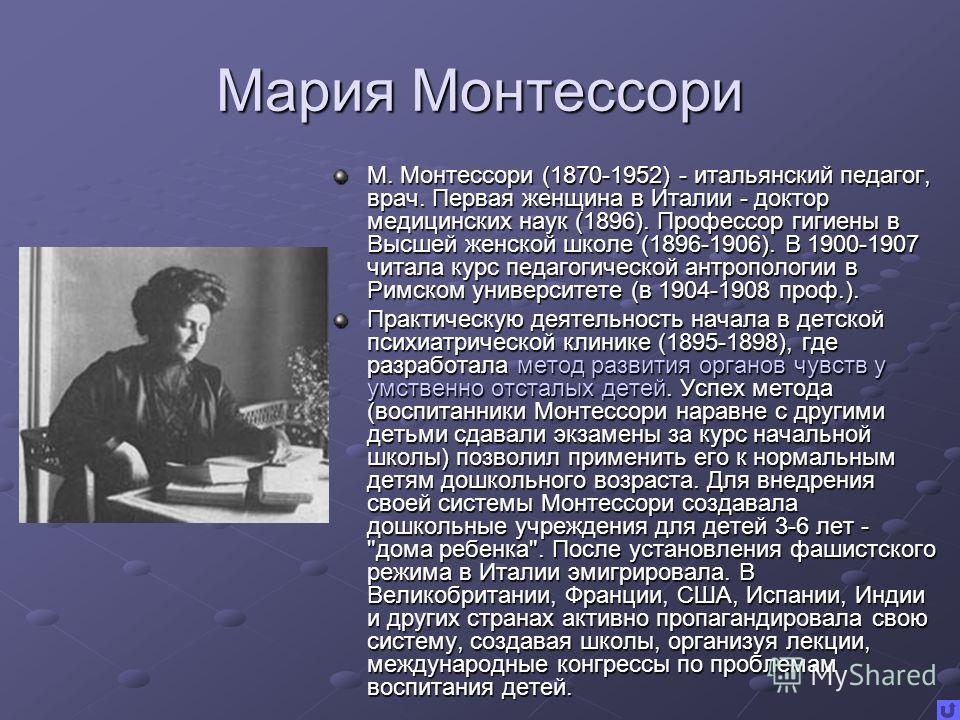
The main idea of the system The main thing in the Montessori system is not manuals, not methods. The main thing is a child, one of a kind, unique and inimitable. And, being one of a kind, he has the right to an individual training system designed for him. The Montessori system gives every child a truly unlimited freedom of choice. Each student here can, at his own discretion, decide what he would like to do today: counting, geography or reading, washing or planting a flower.

The main task of the educator The main task of the educator is to create an active development environment in which there are no random objects and details. Each element of such an environment must perform a strictly defined function. Perhaps the first thing that Montessori does in her new school is, once and for all, expelling Her Majesty Partu from the class, which she believes limits not only the physical activity, but also the child’s cognitive abilities.
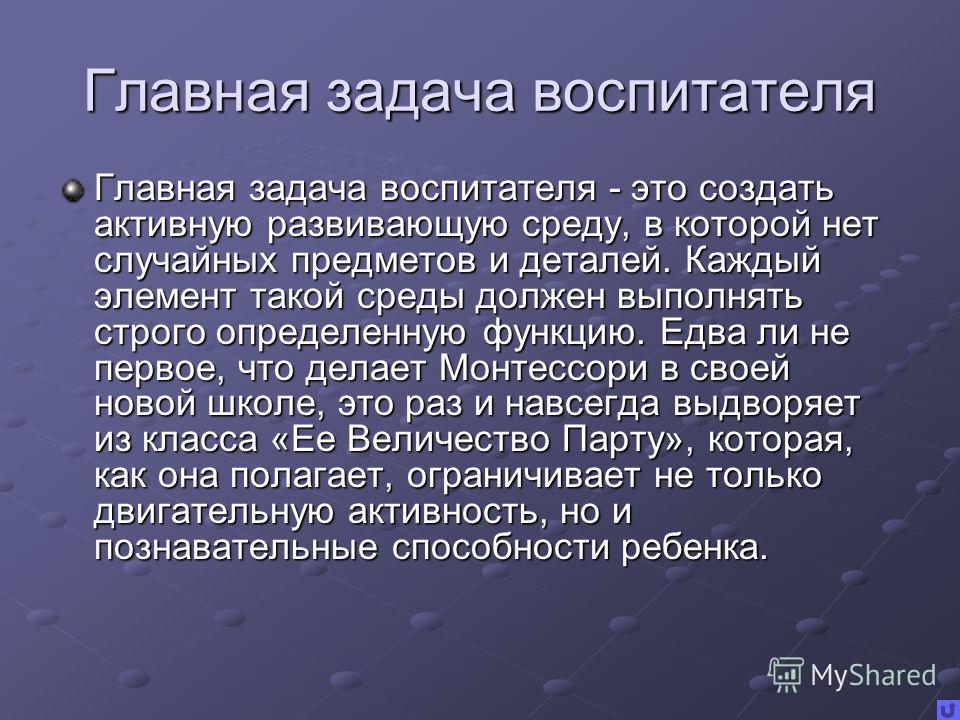
The main form of education and training Independent individual classes of children or individually developed individual lesson by Montessori, the basis of which is conciseness, simplicity and objectivity (that is, the maximum concentration of the child on the subject of activities). Collectively conducted music and gymnastics classes, as well as classes in service work (washing dishes, cleaning, etc.).

Five zones of the Montessori class practical life zone practical zone sensory development zone sensory development zone mathematical zone mathematical zone language zone language zone "space" zone "space" zone
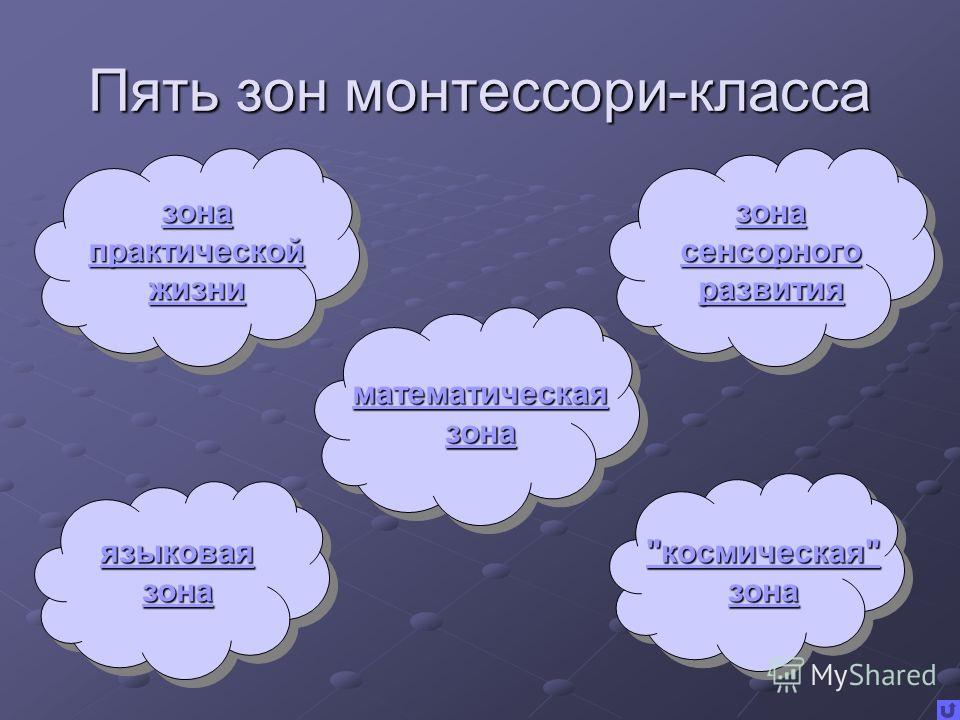
In the zone of practical life, the child learns to serve himself and others. Here you can really wash things in a basin and stroke them with a hot iron, chop vegetables for a salad with a sharp knife, clean your shoes with a real shoe polish. In the area of sensory development, the child distinguish objects according to certain characteristics. Here are materials that develop tactile sensations, sight, hearing, smell.

In the mathematical zone, as you might guess, there is material that will help the child learn the concept of quantity and its connection with the symbol, learn how to perform mathematical operations. In the language zone, children learn to read and write. The zone, which is often called the "space". Here, the child can get the first ideas about the world, about the interrelations and interaction of phenomena and objects, about the history and culture of different nations.
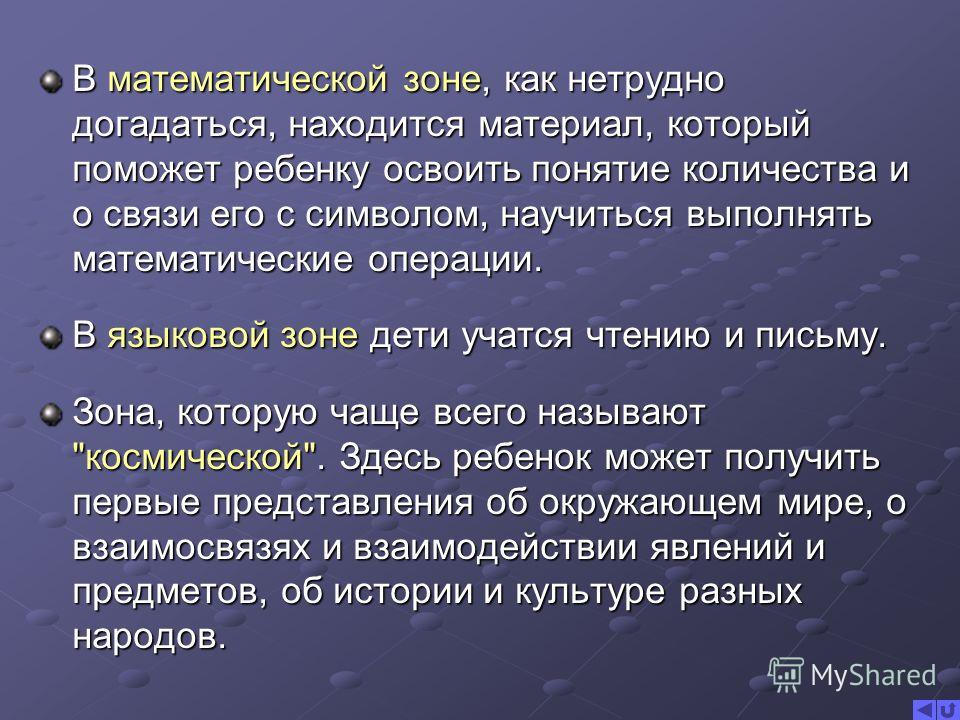
Disadvantages of the pedagogical system The development of the left hemisphere and practically no attention is paid to the “creative” right hemisphere. The development of the left hemisphere and almost no attention is paid to the “creative” right hemisphere. Rejects baby artistic creativityin particular, drawing. Children's artistic creativity, in particular, drawing, is deviating. Selectivity of literature for reading Selectivity of literature for reading

The first drawback The main disadvantage is that Montessori Pedagogy, perfectly developing analytical skills, logic, fine motor skills, that is, those areas of activity that are controlled by the left hemisphere, practically do not pay attention to the “creative” right hemisphere, which, unlike the left one, cognizes the world integrally. In the classic Montessori kindergarten, children do not play spontaneous creative games, here they are considered useless, not helping the child’s intellectual development, but, on the contrary, inhibiting it. Children engaged in developing intellectual games there is almost no time for banal dolls and buckles.
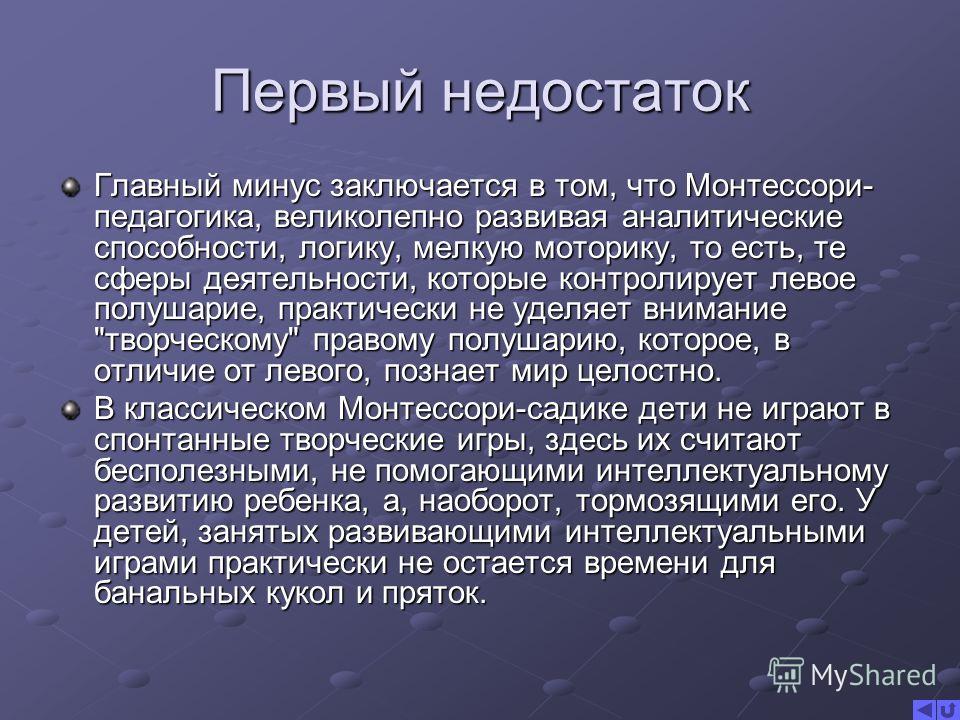
The second drawback is strongly rejects Montessori pedagogy, children's artistic creativity, in particular, drawing. One of the prominent ideologists of Montessori pedagogy in Russia writes about this: "No one pays attention to the fact that perhaps the hand of a child is still sluggish, his mind is insensitive to the beautiful and ugly and admiring all "kalyaki-malaki" is only evidence of a certain level of muscular and spiritual chaos ... Montessori considered the development of the child’s departure into the fantasy world, born of his desire for tip-over and to get away from the problems faced by the baby in your life. If this world is not connected with reality, it is more akin to hallucinations addicts than meaningful work. The creative ability of the mind Montessori considers, as a means to work on reality. "

The third drawback The difficult situation is with reading, a subject to which it would seem that the Montessori system receives so much attention. Montessori pedagogy, although it does not directly deny fiction for children, but tolerates it only because "fairy tales contain not only a huge vocabulary, but also elements of folklore, and in this sense they are useful for the development of the child." Any activity, including reading, should bring real benefits to the child: to develop his speech, to help in the knowledge of the real world, to expand his horizons. But to be able to smartly put letters into words and be a reader is not the same thing. Therefore, why is it generally written and read? fiction: the art of empathy, reflection, internal dialogue with the author and the characters of the text being read. As a result, a child with all his mind runs the risk of growing emotionally undeveloped.

M. Montessori perceives a small child as the most pure carrier of the Creator's intention. Then the main task of adults is not to destroy this plan with their intervention. These ideas are not always perceived by those who undertake to work on the system of M. Montessori. Nevertheless, they are quite organic for her pedagogy and give her harmony and completeness.
